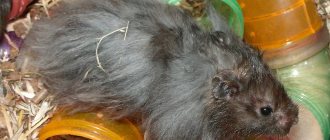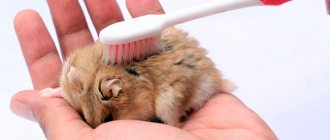When breeding hamsters, the following main factors need to be taken into account:
- hamsters kept together do not get along very well, so the male and female should live in separate cages, they need to be brought together on neutral territory, and under the supervision of the owner. An exception to this rule is Roborovsky's hamsters;
- at the time of the first mating, both the female and the male must be at least four months old;
- after the next birth, the female must have at least two months before the next mating;
- A female older than one year cannot be bred.
Keeping hamsters of different sexes before mating: together or separately
Before mating, hamsters must be kept separately , otherwise they may breed too often. This situation can cause weakening of the female’s body and the birth of weak offspring. Therefore, mating of hamsters for reproduction should be carried out as planned.
When forming breeding pairs, the following should be considered:
- a large female cannot be mated with a small male, she can behave aggressively and harm him;
- a small female is not mated with a large male, since the offspring can take on the size of the father, and she will have problems giving birth to such large babies;
- you should not bring relatives together, as they may give birth to unhealthy offspring burdened with genetic abnormalities;
- you should not breed aggressive individuals - such behavior can be genetically determined and inherited;
- fatty individuals should not be combined. First, you need to review their diet and switch them to lighter foods containing less fat and carbohydrates and more vitamins in order for them to lose excess weight. Hamsters that are too fat are often infertile, and your efforts to breed them will be in vain.
Important! Many people keep hamsters in pairs, and this is wrong. These rodents are solitary by nature and do not respond very well to proximity. Same-sex individuals may begin to fight for territory, which may lead to the death of one of them.
When a male and female hamster live together in a cage, mating occurs during the female's estrus period. In this case, the hamster may experience lactation and pregnancy at the same time, which greatly weakens her health.
Pair selection
To start breeding Djungarian hamsters at home, it is recommended to have 1 male and 2-3 females. The choice of a breeding pair should be taken very seriously. It is better to buy hamsters from different breeders so that they are definitely not related.
At the time of purchase, the weight of rodents must exceed 35-40 g. Preference should be given to hamsters that have reached two months of age. When choosing future breeders, it is important to make sure that they are not sick. Healthy hamsters have clear eyes, shiny, beautiful fur, and dry under the tail. Such rodents are active in the evening and willingly accept treats. For successful breeding, you should choose hamsters of the same species and the same age.
Important! You cannot mate two dwarfs with tangerine or pearl color. The offspring of such parents will be born non-viable. Parents with different colors are suitable for breeding. Two individuals with classic, wild colors can be crossed.
Each rodent will need its own cage. In rare cases, females may cohabitate with each other if they have been raised together since birth. Such rodents can be housed in one cage, but each one must have its own house. The male is kept separately - Djungarian hamsters reproduce very quickly if this process is not controlled.
Some breeders divide the common home into parts with lattice partitions so that individuals of different sexes can see each other. You can put 2 separate cells next to each other. At the same time, hamsters get used to the smell of their relatives and do not fight. Thanks to this proximity, it is easier to determine when the hamster is ready to breed.
Puberty
Females can become pregnant as early as 3-6 weeks of age. The animals' bodies are still growing during this period, and by allowing such a young animal to become pregnant, you can significantly reduce its lifespan. The offspring of such early pregnancies are often born non-viable. Females that are too young produce little milk, and the cubs may simply die of starvation. In such cases, the hamster can even eat its offspring.
The best age to start mating is considered to be 3-6 months. If the female has not bred for up to 6 months, then she should no longer organize mating. Such late pregnancy and childbirth can have many complications.
Males can be used for breeding from the age of 5 weeks.
Find out more about keeping hamsters: what breed of hamster to choose, how long do hamsters of different breeds live, how much does a hamster and its maintenance cost, how to train a hamster to respond to its name.
How to determine pregnancy and how long it lasts
A positive result appears one and a half weeks after mating. Previously, it was difficult to see the signs.
Main signs of pregnancy:
- Enlarged tummy. Sometimes, due to the long fur, this may not be visible.
- Swollen nipples.
- Increased appetite.
- The animal is less active and rarely runs in a wheel or maze.
- Behavior changes: a pregnant girl becomes more aggressive or more affectionate.
- Actively stocking up.
The presence of these symptoms signals the imminent appearance of offspring.
Pregnancy lasts about 19 days. Syrians are born 16–18 days after mating. Djungarians appear later. Sometimes pregnancy can last a month.
The movements of the expectant mother are smooth and unhurried. Try not to disturb her during this period. A few days before giving birth, your pet needs to increase the amount of water and protein in its diet.
Babies are born without outside help. The mother independently separates them from the shell and cares for them in the built nest. A rodent litter contains from 4 to 18 babies.
How often do hamsters breed?
You cannot mate a female more than six times a year , since the body will not have time to recover after childbirth, which will negatively affect the health of the cubs. It is best to take a break between matings of 3-4 months. It is optimal to limit the number of breeding periods to three times a year.
It should be borne in mind that some females become infertile at 12-14 months. But males do not lose the ability to reproduce throughout their lives and always show interest in the opposite sex. But they should not be used frequently for conception, since with frequent mating their ability to reproduce decreases, and the females do not achieve the expected pregnancy.
Did you know? Hamsters differ from other rodents in having cheek pouches that can hold up to 50 g of food or building materials. Their thrifty nature is well known; hamster reserves can reach 90 kg. These animals sometimes cause considerable damage to agricultural land.
When to place rodents?
The sudden appearance of a cat next to hamsters preparing to mate, or an unexpected sharp sound can drive the animals into severe stress. They are capable of not only abandoning the task assigned to them, but also starting to fight. The mood of those getting married changes very quickly, regardless of their type. Fights can be so serious that one of the animals is severely injured or killed. Usually the strongest blows go to the male.
The following describes situations in which it is better to postpone mating of hamsters until better times:
- The girl initially did not like the male. In this case, you need to introduce the hamsters gradually or choose another boyfriend for your pet.
- The girl is not ready. If the hamster is not currently in heat, she will react especially aggressively to a furry man who appears nearby. Be sure that the lady will use not only her claws, but also her teeth. In such a situation, it is necessary to urgently remove the Djungarian boy and wait for the moment of estrus.
- Sudden fear. Due to stress, both hamsters can simply go wild and start fighting. In this case, their separation is necessary.
- The process is over. Not all hamsters, unlike individuals of the opposite sex, are ready to copulate all night. When the female decides that she has had enough, she will become restless and begin to show bouts of aggression. In this case, the partner should also be removed.
Sometimes hamsters can be left alone for half an hour to do their simple task. But you can leave only if the pets have established contact and they treat each other favorably. Still, it’s better to be nearby in case of a hamster force majeure. Usually the gentleman manages to inseminate the female within half an hour, then he can be separated.
By the way, some rodents have no complexes at all: they manage to mate in the presence of their owners, almost sitting in their arms!
In the photo copulating Syrians:
When to place a female with a male
Hamsters should only be mated during the female estrus period, which occurs every 3-5 days. This condition usually occurs in the evening and lasts 4-24 hours.
Signs of estrus in females are:
- restless behavior;
- poor appetite;
- increased odor;
- Mucus discharge is observed under the tail.
In some varieties of hamsters (Djungarian or Campbell's hamsters), signs of estrus are hardly noticeable.
Hamster hygiene
Long-haired animals need to be brushed regularly. You should pay attention to their hind legs and belly, as tangles often form in these areas. For hamsters with short fur, clean it with a damp brush. These rodents should be bathed only when they are very dirty, using a special shampoo.
To maintain the normal condition of hamsters' teeth, it is recommended to leave branches of fruit trees in the cage. Solid food is required for grinding down the incisors. If the teeth grow too long, you will have to contact a veterinarian. The claws of healthy and active individuals grind down on their own. They only need to be trimmed on old animals that don’t move much.
Why it might not work out
Before mating, it is advisable to introduce the hamsters, then the mating will be effective. Some neutral place or area where a male hamster lives is suitable for this. You cannot bring these rodents into the female’s home.
A thick box made of cardboard or plastic is perfect for this purpose , since if the hamsters start fighting inside the cage, it will be difficult to separate them immediately, and they will have time to injure each other. You must first protect your hands with leather gloves from the bites of these rodents.
Pregnancy in a hamster does not always occur during the first mating. Therefore, mating must be repeated until the expected event occurs.
The following reasons may be serious obstacles to pregnancy:
- same-sex couple. Before mating, you should carefully examine the animals and accurately determine the sex;
- obesity. As we have already said, excess weight negatively affects conception. If the animal is overfed and when walking its tummy touches the surface, then it should be put on a diet;
- poor nutrition. A lack of certain vitamins and other substances can prevent pregnancy and even provoke the female to eat her offspring;
- diseases. After certain illnesses, hamsters' bodies must recover in order to be able to reproduce;
- stress. Some stressful situations (crowded housing, constant noise and light, an annoying cat or dog) prevent the reproduction of these rodents.
Did you know? Hamsters are quite active and mobile animals. Under natural conditions, they walk long distances (up to 10 km) in search of food. Therefore, you need to provide sufficient activity for your pets by placing a wheel in the cage.
Pros and cons of breeding dzhungarikas
Breeding Djungarian hamsters is not that profitable. The retail price of a young individual rarely exceeds 200 rubles, and breeders sell rodents to stores in bulk for a lower price. It turns out that the owner gets about 100 rubles from each hamster, and 500-600 rubles from one litter. At the same time, he spends much more on the maintenance and care of his pets - he invests money in cages, food, supplies, and veterinary care.
There are other difficulties in breeding dzhungariks. During breeding, the female and her children need complete rest. It is quite difficult to provide this if the rodents were purchased for children.
Another problem that Djungarian hamster breeders face is finding a new home for their growing rodents. A lot of babies are born, so it can be very difficult to place them in good hands.
Breeding Djungarian hamsters at home also brings little benefit. Females live much longer when they do not waste their body’s energy and resources on bearing offspring and giving birth. Animals do not suffer at all from not reproducing.
Obviously, the reproduction of Djungarian hamsters is a fascinating process. But it requires a lot of time, effort and material costs from the rodent owner.
Where to keep and what conditions should be created for a pregnant hamster
A pregnant female needs more attention. There should be no obstacles to drinking and food. During pregnancy, the female needs to be provided with walks , but it is important that she is not frightened.
The walking ball allows the hamster to move freely around the room or apartment. This allows him to maintain the necessary activity, as well as periodically change the environment, which is important for the psychological state of the rodent.
It is necessary to monitor the constant temperature and humidity in the room where the cage is located. During this period, the cage should be cleaned less often and not moved to another place. But before the expected birth, it should be thoroughly cleaned, disinfected and placed in the place (house, shelter) in which the birth will take place, fresh bedding (preferably chopped hay).
While waiting for offspring, the female hamster's diet should be balanced and contain more proteins and calcium. The diet should include greens (alfalfa, clover), carrots, sprouted cereal grains, give more cottage cheese and pieces of boiled meat. You can also add beaten eggs and dairy cheeses to the menu. It is also recommended to add a piece of chalk or calcium gluconate, as well as a tablet of activated carbon and phytin.
We recommend reading about the nutritional habits of hamsters.
Before childbirth and in the first seven days after it, glucose and preparations containing calcium are added to the drink. In the first 7-10 days of pregnancy, the amount of food for the expectant mother is increased by a third, but in the next 10 days the increase occurs twofold.
2-3 days before giving birth, the hamster becomes very thirsty, so it is important to ensure that there is a sufficient amount of liquid in the drinking bowl and change it constantly. It is advisable that the drinking temperature be about 20 °C. You can use tomato juice and rosehip infusion as a drink.
Video: caring for a pregnant hamster
Choosing a partner
You already know at what age jungariks and other animals will reproduce best. If you have one Homa living with you, it’s time to choose a mate for him.
- Firstly, the partner must be the same breed as your pet. That is, a Djungarian hamster must mate with a Djungarian hamster, and a girl Syrian hamster must mate with a Syrian, etc. Interbreeding of hamsters at home rarely brings results.
- Secondly, the partner must be of the opposite sex. And you already know how to determine the gender of rodents.
- Thirdly, both animals must be healthy, free from external pathologies and infectious diseases, so as not to give them to future babies.
- Fourth, choose a partner who is similar in appearance to the female. This will increase the chances of producing a pure line of hamsters (line breeding).
- Fifth, try to avoid inbreeding, when hamsters that are siblings, parents and children mate. Such crossing will increase the chance of pathologies and deformities in the offspring.
The couple must not only match in appearance, the male and female must like each other. Choose a time when both animals are active, fed and happy. This will increase the chance of having intercourse “on the first date.”
How long do hamsters bear offspring?
Female hamsters bear their offspring for 16-20 days. The gestation period of Djungarian hamsters is longer - 18-30 days. On the tenth day, the females already have a noticeable tummy. They most often give birth at night, and lactation lasts up to 25 days.
Important! Immediately before giving birth, it is important to control the presence of a sufficient amount of water in the drinking bowl, since immediately after giving birth, the mother hamster experiences extreme thirst and, if there is no drink, can eat her cubs.
Pairing
Breeding Djungarian hamsters at home is not an easy process. Mating of rodents is possible only when the female goes into heat. At this time, the hamster is at the peak of excitement, so she allows the male to have sexual intercourse.
Estrus in Djungarian hamsters occurs every 4-5 days and lasts about a day. For successful breeding, it is advisable to cross the hamster within the first few hours after the onset of estrus.
You can determine the onset of estrus in a dzhungarika by the following signs:
- under the hamster's tail the fur becomes damp;
- the female does not show aggression towards the male.
To breed Djungarian hamsters you will need a separate cage. These rodents prefer to mate on neutral territory. If this is not possible, mating can be carried out in the male’s home.
Creating favorable conditions for reproduction
The breeding cage for Djungarian hamsters does not have to be spacious. You should remove all unnecessary objects in advance - a wheel, toys. You only need to leave the feeder, water bowl and house.
The favorable time for breeding is in the evening, when hamsters become more active. Rodents usually sleep during the day. It is advisable to place the cage in a quiet room. It is necessary to limit the access of other pets to rodents and ensure that the room has a comfortable temperature within +20...+25 degrees.
During a short acquaintance, a male hamster cares for a potential partner, and she tries in every possible way to attract his attention. The female raises her butt and freezes in a position that is characteristic of mating. Thus, she demonstrates her readiness to reproduce.
Hamster mating process
Hamster mating lasts less than a minute. The male runs up from behind and performs sexual intercourse. After this, the rodents can be left together for a while longer so that they have the opportunity to mate several more times until the female stops estrus.
At the end of the mating season, the rodents are separated from each other. If different-sex Djungarian hamsters are kept in the same cage, gestation will coincide with lactation. The cubs will die, and the parents will begin to eat the offspring.
Important! Ladders and a running wheel should be removed from your hamster's cage to prevent injury while she is pregnant.
How many hamsters are born
Fertility of hamsters is very high, especially when they receive enough food and do not hibernate.
Due to their ability to regularly give birth, these rodents are popular in laboratories when conducting various studies.
Depending on the variety and care, hamsters can reproduce different numbers of offspring. For example, hamsters of the Djungarian species give birth to 4-6 babies, less often 8-9. But dwarf hamsters are less fertile due to their small size. Syrian hamsters always produce high litters. This is usually 8-10 babies, but the number of offspring can reach up to 20 pieces.
Contraception methods
The high fertility of small rodents can cause a lot of trouble for their owners.
High fertility causes a lot of problems for the owners of cute animals. The only way to protect against unwanted offspring is to seat girls and boys in separate cages.
There are no birth control pills available, and veterinarians do not sterilize hamsters. They can do this only for medical reasons, for example, a tumor is discovered in a hamster.
The only method of contraception is keeping pets apart.
Care of offspring
After the birth of offspring, caring for hamsters has its own specifics. The cage is not removed for 14 days, the temperature is maintained at +21...+25 °C . During this period, babies should not be touched or disturbed, so as not to cause stress in the nursing mother. The hamster's diet includes balanced protein foods enriched with fats. Hamsters begin drinking water 10-20 days after birth.
If for some reason the mother cannot feed her offspring, then the cubs are fed using a pipette with a special hamster milk substitute or powdered infant formula. After 7-10 days, the cubs begin to look for food on their own. During this period, you can throw grated carrots, cottage cheese and other food . They provide more food so that there is enough for both the mother and her offspring.
If there is no house in the cage, then you need to place a small cardboard box in it so that the mother and babies feel protected. If the hamster is provided with building materials, then she will arrange housing on her own. In addition to sawdust and filler, napkins or paper towels are also placed in the cage for easy cleaning.
Check out these tips for setting up a hamster cage.
For this purpose, you should not use cotton wool or cloth so that the hamsters do not get entangled and suffocate. The cage should not be tiered and have differences in height, and the spaces between the bars should be such that the cubs do not fall out of the cage. Feeders should be placed in such a way that babies can easily find them, and water should not be placed in open containers.
If suddenly a newborn hamster falls out of the nest or house, then it must be carefully moved back not with the help of hands, but, for example, with a spoon . The cage is located in a quiet place and protected from direct rays of the sun, and drafts are not allowed.
If there are small children in the house, they should be instructed that they do not need to handle small hamsters for two weeks. After the grown-up babies are moved to different cages, you can begin to tame them so that they get used to humans and do not bite their future owner.
Video: keeping hamsters
Sexual intercourse in hamsters
It is not customary for domestic rodents to have long foreplay; usually, after a short introduction and sniffing, they immediately get down to business. And why wait, because their life is so short!
So, you left your pets alone in a secluded place. If the female is completely ready for mating, then the male piles on top of her and hugs his girlfriend around the waist with his tiny paws. The submissive bride does not object, she leads the seed quietly and meekly, but Don Juan is very active! The mating process for representatives of the Dzungarian breed and other dwarfs lasts no more than 5 minutes; Syrians usually inseminate a hamster longer.
If a couple consists of a very calm girl and a small active boy, they may have intercourse several times throughout the night. In such cases, in the morning the male falls exhausted. Such a vigorous sex life can undermine the health of a hamster and even temporarily drive it into stupor.
In the photo, Roborovsky’s gentleman hugged his chosen one:
Sometimes problems arise during or before sexual intercourse. You need to know when it is better to place a couple in different cages.
When can baby hamsters be separated from their mother?
You can separate offspring from a hamster from the 3-4th week of life. At 28 days, the cubs do not need a mother, and also already have the ability to reproduce. Therefore, they are separated to prevent early pregnancy and the occurrence of aggression on the part of the mother. But if the cubs were born weak and very small, they can be kept with the hamster for up to 5 weeks, but no more.
Babies are not distributed immediately after separation from their mother. Females are separated from males and placed in different cages, which have everything necessary for keeping hamsters - drinking bowls, feeders, bedding, houses, etc.
Rodents that can be kept as pets include rats, squirrels, degus, chipmunks, guinea pigs, gerbils, jerboas, prairie dogs, and dormouse.
Hamsters can be given away at the age of 1.5-2 months. They try to give away hamsters a little earlier, since already at seven weeks the fight for territory begins, and each hamster needs a separate home. When transferring hamsters to a new owner, it is advisable to give some of the filler that has already been used and food for the first time. The familiar smell and food will reduce the stress of changing your place of residence.
After childbirth
Newborn babies spend the first 7 days in a nest built by their mother and feed on milk. For three weeks, the offspring and mother try not to be disturbed. A woman in labor may react aggressively to actions directed at her children or refuse them altogether.
During the first weeks of a baby’s life, the bedding is not changed; new ones are added as needed. Monitor the amount of food in the bowls and periodically add new ones. After 3 weeks, the children are removed from their mother and monitored in a new house. It is necessary to determine the sex of the cubs in time and place them in different homes. Animals can be distributed a month after birth.
Is it possible to castrate hamsters
Frequent estrus does not particularly bother the hamsters themselves and their owners, so there is no point in sterilizing the rodent . In addition, due to the small size of the animal and poor perception of anesthesia, this procedure is practically not used.
But if there are indications for castration of hamsters - tumor of the testis, pyometra, tumor of the uterus, then it is necessary to find out which veterinary clinic performs sterilization and carry out this procedure.
Did you know? There are 12 species of hamsters living in the wild in Russia. All of them are carriers of 30 infectious diseases, some of which can be fatal to humans. So the bite of wild animals is dangerous to health.
Arrangement of the cage
The monastery should be quite spacious; sawdust, odorless corn and wood filler, coarse sand should be placed at the bottom, but cotton wool and shreds should not be placed in the cage. A shelter is required (it can be a wooden house or an upside-down clay pot with a hole). You can train rodents to go to the litter tray - there are even special toilets with litter on sale. The sooner you start training, the greater the likelihood of success; it is almost impossible to retrain an adult.
To prevent the animal from getting bored, it would be good to purchase climbing tubes, build “minks”, ladders, a wheel is also useful for hamsters, but it should not be mesh or slippery. It is better to choose an adjustable, drip-type drinking bowl, since hamsters like to turn the drinking bowl over or splash water out of it. The feeder must be securely attached to the grate or be heavy so that the animal cannot turn it over.
Can you imagine a hamster without a pantry? – In some part of the cage, your pet will definitely equip itself with storage, where it will hide part of the food “in reserve.” When cleaning the cage, be extremely careful and do not take away the hidden food, otherwise the animal will be really stressed.
Comfortable conditions for reproduction
Numerous offspring
Well, after you have figured out the type of hamsters, the number of cages for them, and the number of females and males, it’s time to create comfortable conditions for reproduction for these small rodents. To do this, you must take care, as we wrote above, about purchasing several cages or terrariums that are spacious enough (the floor area of the cage should be no less than 30 x 50 centimeters). This is necessary so that the animal has space to run and frolic. So, for dwarf breeds of hamsters - these are Djungarian, Chinese, Roborovsky and Campbell hamsters, it is necessary to adhere to these exact sizes, since they are very active. If it is not possible to purchase such a large cage, you can try to win by having several floors in the cage. As for the rods in the cages, in addition to the fact that they must be very strong, their optimal placement is horizontal. This way, the hamster will be able to climb them like a ladder.
Do not forget about installing a drinking bowl, feeder, and running wheel for play in such a cage. Many hamster owners often simply install a bowl of water instead of a drinking bowl - but this is not entirely correct. Since the hamster can overturn such a bowl, the water will spill, the litter will get wet and you will have to clean and put away the cage. You will avoid all this if you install a special drinking bowl - the hamster will definitely not turn it over. In addition, using a drinking bowl, you can easily dissolve vitamins and special additives in such drinking water, and you will monitor the amount of water that the rodent drinks. Well, a running wheel is a must-have for maintaining healthy physical shape. You won't believe it, but
In nature, a baby hamster runs up to 12 kilometers a day, and at the same time he feels good. But a passive lifestyle in your cell negatively affects it...
If you have the desire and the area of the cage allows, you can also install a house and a toilet in it. Don't forget about toys - you can see walking balls or pens in veterinary and pet stores. True, here it is necessary to take into account the individual characteristics of the hamster - one enjoys traveling in a walking ball, while the other is afraid of it for some reason...
As for the choice of filler for a cage with hamsters, we had a whole publication about this on our website, but we would like to remind you that it is still recommended to opt for sawdust - pressed or granular, at your discretion. If possible, you can use hay or special pressed cellulose filler. As for paper and napkins, this is a controversial issue. Although, some breeders claim that hamsters build nests from this material. But what is strictly forbidden to use as a material for such a nest is cotton wool. Moreover, any one, even one that may say that it is intended for use in cages with small rodents. The fact is that thin fibers of cotton wool can wrap around your pet’s paws and disrupt blood circulation in his limbs. As a result, the paw may completely atrophy, and the animal may die. Well, if the hamster “thinks” of eating cotton wool, it can damage its intestines with its fibers. A similar taboo for using in hamster cages is newspapers and magazines. The sheets of these publications contain “tons” of printing ink, a drop of which can kill our beloved hamster.
Don’t forget to place a special stone in the cage on which the rodent will grind its teeth. There are several types of such stones - chalk, mineral, they can have different shapes, sizes and colors. By the way, an alternative to such stones can be branches of fruit trees - a natural product.
Video about hamster breeding:
Many hamster owners complain that they seem to be doing everything right, but instead of the long-awaited offspring, a couple of hamsters begin to get sick, or even die. Why? What is the reason? Look carefully where the rodent cage is located. If this place cannot be called quiet (there is a TV or radio nearby), there is a hot radiator nearby, the sun's rays fall on it from the window (by the way, bright and direct sunlight is contraindicated for hamsters), there are objects dangerous to health nearby - cords, curtains, a rodent can drag them into a cage and chew them, hamsters are disturbed by curious children or other pets - it is not surprising that rodents are in a constant state of stress, can get sick and even die.
Unsanitary conditions in the cage are another reason that you may fail. After all, if you do not regularly clean the cage, in addition to the unpleasant odor in it, dangerous microbes will appear on all its surfaces, which will pose a potential threat to the health and life of your pets. Where can we reproduce here? The main thing here is to survive...
Hamster diet required for breeding
Candy-bouquet period
If you plan to get healthy offspring from your hamsters, you must feed the parents themselves properly. If they are malnourished, say, there are no vitamins in their diet, the menu is unbalanced, then there can be no question of any breeding. Therefore, be patient and include ready-made dry grain mixtures in your Hamka’s diet (by the way, you can make them yourself by mixing several types of cereals in equal quantities). But under no circumstances should you give pasta either dry or boiled to small pets. When boiled, they can cause indigestion; when dry, they can injure the cheek pouches of the thrifty Khomka. Don’t forget to pamper your rodent with grain sticks, grass granules and rings, special crackers and cookies for rodents, drops, dried corn on the cob, dry fruit mixtures... And, of course, there should always be clean and fresh water in the cage...
Support your hamsters’ body with special vitamins, add fruits, herbs and vegetables to their diet...
Guided by these basic principles, you will not only be able to count on healthy and numerous offspring from your hamsters, but will also make the life of your rodents the happiest...
Living two hamsters in one cage
If there is no second cell, the partition will not help. Friendly and family ties are alien to rodents. Hamsters are nocturnal animals. Therefore, there is a high probability that at night they will simply gnaw each other. The ideal option is a separate cage with personal toys and exercise equipment. This type of content is the most comfortable for the animal. You should do the same with the cubs. As soon as the babies reach the age of one month, they must be immediately placed in separate housing.
Estrus
A female hamster can only become pregnant at a certain time in her cycle - once every 4 or 5 days. If you miss the moment, then there is no point in replanting the male the rest of the time. The female shows her readiness to mate with her behavior. At this time, she begins to raise her tail, arch her back and secrete a substance with a strong odor.
Scientifically, this condition in animals is called “estrus.”
Usually, owners of dzhungarikas notice this behavior in the evening. The average duration of estrus is 6−12 hours. Sometimes it can last up to a day. At this time, a male should be placed with her as quickly as possible.










